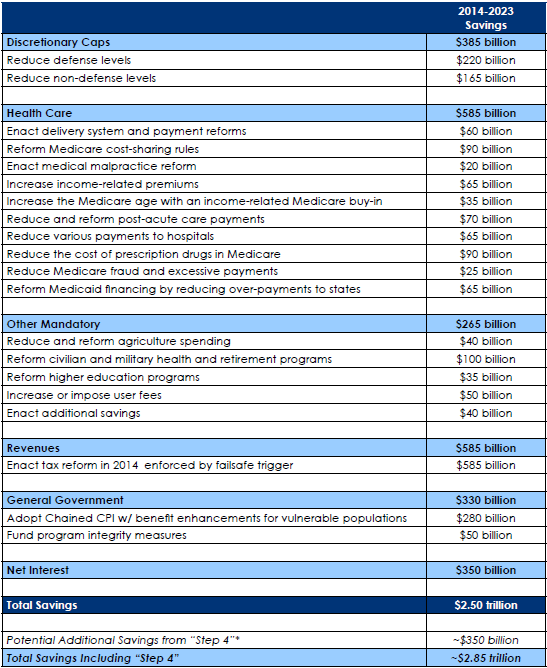Simpson and Bowles Release "A Bipartisan Path Forward"
Today, the former co-chairs of the Fiscal Commission, former Senator Alan Simpson (R-WY) and Erksine Bowles, released "A Bipartisan Path Forward to Securing America's Future," their detailed fiscal plan that would replace the abrupt and mindless cuts under sequestration and put debt on a downward path as a share of the economy with an additonal $2.5 trillion in deficit reduction.
Since the Commission's 2010 report, lawmakers have made some progress in getting our fiscal house in order with an estimated $2.7 trillion in enacted savings through continuing resolutions, the Budget Control Act, and the American Taxpayer Relief Act. However, most of the easiest savings have already been enacted, and debt is still far from being on a sustainable path. The new plan is intended to be "Step 3" of the needed deficit reduction effort ("Step 1" involved reducing discretionary spending and limiting the growth of that spending, while "Step 2" enacted modest increases in revenue and minor cuts to spending).
Simpson and Bowles previously laid out a framework for this "Step 3" in late Feburary, but the report released today presents the specific policy options that would achieve the needed deficit reduction. The report also presents a path forward to achieve "Step 4," which would include reforms to ensure the 75-year solvency of Social Security, restore the Transportation Trust Fund, and limit the growth of federal health care spending per capita to the growth of GDP.
Below are the policy changes included in "Step 3," measured from a current policy baseline identical to CRFB realistic.

Source: Bipartisan Path Forward
Under the proposal, debt would fall from 76.4 percent of GDP in 2013 to 69.3 percent of GDP in 2023, compared to 79.0 percent of GDP under our CRFB realistic baseline. Revenues would be 19.7 percent of GDP in 2023 compared to 19.1 percent under the CRFB realistic baseline. Spending under the plan is projected at 21.6 percent of GDP compared to 23 percent under our baseline. If lawmakers took "Step 4" of the plan, debt levels would be even lower.
It's very encouraging to see a bipartisan approach that exceeds CRFB's recommendation for $2.4 trillion in additional deficit reduction. Along with the already released budget proposals, lawmakers could use the "Bipartisan Path Forward" as a guide for replacing sequestration with smart deficit reduction. We will be following up with more analysis of the plan soon.
Click here to read the full report.

